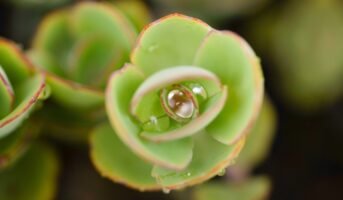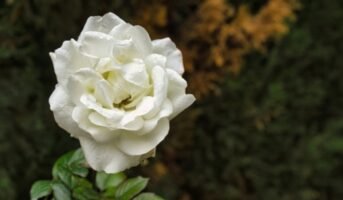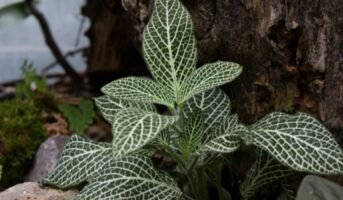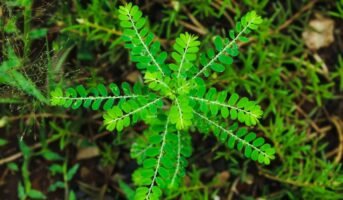Euphorbia Grantii, also known as the African Milk Bush, is a perennial plant of the Euphorbiaceae Genus. They are succulent plants. This sparsely branched shrub produces abundant latex (white toxic sap). These plants are widely kept as decorative and household plants.
Euphorbia Grantii: Facts
| Family | Euphorbiaceae |
| Common name | African milk bush |
| Category | Houseplants, shrubs |
| Type | Succulent |
| Leaf type | Stiff, sword-like, green-banded coarse leaves with a yellow border, evergreen, poisonous.
|
| Plant Characteristics | Low maintenance, poisonous |
| Flower Characteristics | Poisonous, unusual, purple coloured
|
| Varieties available | 6,745 species |
| Height | Individuals can grow up to 1.5m (59 inches) |
| Season | All year round |
| Sun exposure | Does best in full sunlight |
| Ideal temperature | Temperature needed: upto 5°F (15°C) |
| Soil type | Sandy soil |
| Basic requirements | Direct sunlight, Sandy soil |
| Ideal location for placement | Does well as a hedge outside, Indoors- near the windows |
| Maintenance | Very low, easy to nurture |
| Water requirement | Not much water is needed as 70% of Euphorbia grantii is water |
| Main challenges | Waterlogging, root rot, mealybugs |
See also: What is Hibiscus and how to grow it in your home?
Euphorbia Grantii: Physical description
- Euphorbia plants vary from flat creeping herbs to shrubs and trees.
- Euphorbias are distinguished by their milky sap as their distinctive feature. They can be identified by snapping their stems and looking for milky sap, but they are poisonous. Thus caution is required whilst handling them.
- Although the leaves are round and green, they can occasionally be variegated with a purple-reddish hue on the underside. It produces tiny, purple flowers when conditions are ideal.
- Euphorbia grantii blooms all year long, which is an intriguing feature.
- Although the flowers are lovely and are rarely seen, these relatively small lovely flowers are meant to be admired and not to be touched because they are just as poisonous as the rest of the plant.

Source: Pinterest
Euphorbia Grantii: How to grow?
These plants require low maintenance and are easy to grow. This significant feature of this plant makes it easier for it to grow indoors, and it works perfectly as a houseplant.
Though these plants do not require much attention, there are several pointers that should be kept in mind while planting euphorbias at home.
- The first step is to inquire about the mother plant’s size when buying a seedling. It plays a vital role in deciding whether the plant should be sown outside or meant to grow inside. Check whether the seedlings are of good quality or not.
- It is better to plant euphorbias outdoors for better growth as they can reach up to their actual height once planted under the right conditions. Once planted in a pot inside the house, its constricted height can be a result of the restricted environment.
- Sunlight is a necessity for their growth. If you keep the plant indoors, the position of the plant should always be near a window where direct sunlight is falling. Do not plant them in winter or under any unfavourable conditions.
- Sandy soil is best for the plant if you plant it outdoors. If you’re growing this plant indoors, you still need to fill your pot with sandy soil for a better growth rate.
- The nutritional aspect of the plant is to be taken care of for its better growth, and for this, loamy soil and some organic matter are to be used if necessary. Succulent commercial mix pumice can also be used to add some nutritional value to your plant.
- Euphorbias don’t need much water for their growth, hence avoid over-watering the plant. Do not place your plants outside for a long time in the rainy season. Overwatering can cause root rot which may lead to plant death.
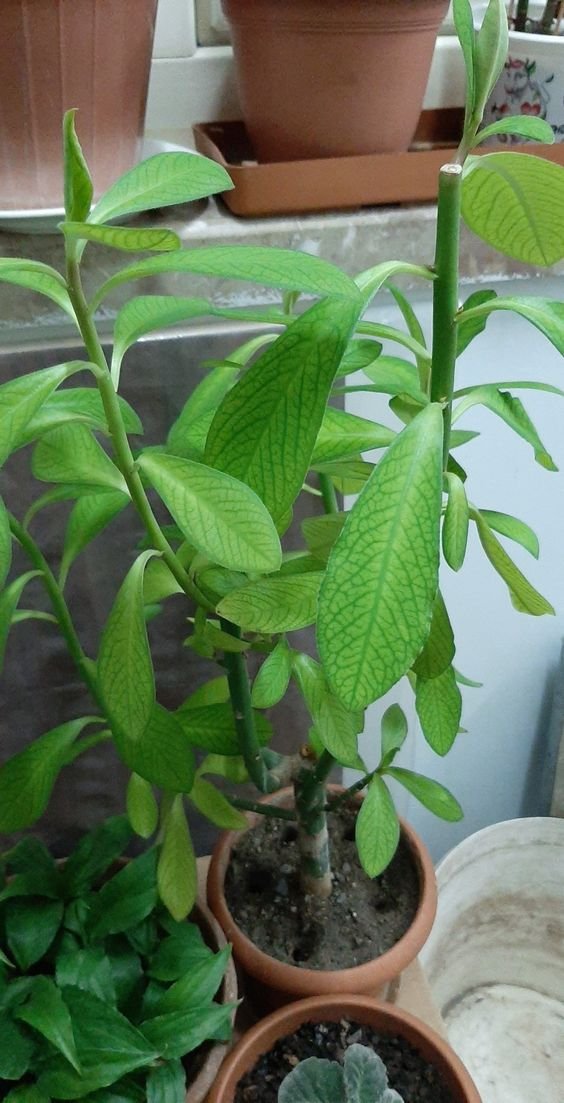
Source: Pinterest
Euphorbia Grantii: How to care for it?
- Sunlight: Euphorbia grantii does best in full sunlight. It thrives as a hedge outside since it enjoys direct sun exposure. The health of the plant, flowering, and optimum leaf colouration all depend on adequate sunlight, like every other plant.
- Indoor plantation: Euphorbia grantii can reach a maximum height of 1.5 metres with a sturdy stem. One of the reasons it can be grown indoors and why it thrives as a houseplant is its height. However, it should be planted in a pot while growing indoors, which could inhibit the plant’s growth directly regardless of its ideal height because of the restricted environment and setting. Thus, euphorbias that are kept indoors are always found to be relatively smaller than their actual size. It can be grown outdoors in the ground but in suitable climatic conditions where it thrives.
- Soil: The fundamental rule one should follow while growing this plant is to always use soil that is easy to drain. Sandy soil is supreme for growing this plant outdoors. While planting euphorbia outdoors, always adopt areas that are sandy. If the area where the plant should be grown is not sandy, dig a hole that is significantly larger than the plant’s ultimate root system and fill it with sandy soil. The ground should frequently be drained where the roots are located. Your plant still needs some fertilizer and a bit of water, though.
- Fertilizers: While planting euphorbia indoors in a pot or any container, one should mix some pumice with a standard succulent mix. While the pumice will enable water to drain, the succulent soil mixture will offer nutrients and aid in some water retention which is a necessary step for the better of your plant.
- Water: Seventy percent of Euphorbia grantii is water, and it must constantly replace the moisture it naturally loses through transpiration and other processes and, thus, needs less water than usual plants. However, overwatering should always be a primary cause of concern as it is the most significant cause of why this plant perishes. Avoiding waterlogging is essential to keep this plant thriving since it leads to root rot, which is why the kind of soil you plant it in is so crucial.
- Grooming: this plant doesn’t need much grooming. Nevertheless, you can regulate the tree’s proliferation by pinching the tops of the stems to foster the establishment of new branches. This practice shouldn’t be done too often. Let the branches of your plant help to develop more foliage for a fuller look. Pinching should only be practiced on young plants as they respond well to it.
- Root rot: euphorbias and other succulents face root rot throughout the year, which is primarily brought on by waterlogging. In order to improve the plant’s health, these two problems should be corrected. One sign that your plant may have root rot is when the leaves of your plant start to turn yellow all of a sudden.
- Debugging: You can perform debugging by examining the season when the yellowing appears. Do not delay this process. Scant watering can make your plant leaves turn yellow. If the plant changes colour immediately after a rainy season or after several waterings, you can infer that watering is the issue.
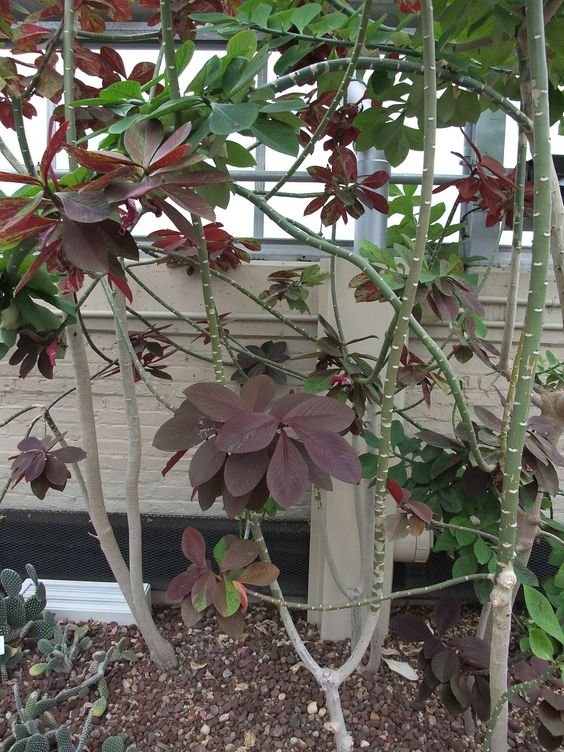
Source: Pinterest
Euphorbia Grantii: Uses
Despite its toxicity, Euphorbia grantii’s milky latex is utilized medicinally. This herb offers numerous health advantages besides being a decorative plant. The communities where Euphorbia grantii is grown extensively use it as a therapeutic plant and take numerous medicinal advantages from it.
- In India, it is used to treat stomach aches, gonorrhoea, constipation, severe diarrhoea (dysentery), intestinal worms (diluted latex is used for the treatment), and other digestive disorders. Breathing diseases like asthma, bronchitis, and chest congestion are treated with euphorbia.
- The corrosive nature of sap has been in use for medical purposes over the years and used for wart removal since ancient times.
- Additionally, it is useful for tumours, blood clotting (putting sap to a wound might cease bleeding), hay fever, throat spasms, and mucus in the nose and throat.
- It can also be used as a tonic for women after giving birth to restore their bodies. Mostly the stem and root of this plant are used for medicinal purposes.
- The eardrops made from the stem or branch of this plant can cure earaches. This plant also helps to keep the environment clean while kept indoors.
Recent studies have demonstrated that the plant has strong antiviral and anti-inflammatory properties.
Euphorbia Grantii: Is it toxic?
The answer is yes! Euphorbia grantii is very toxic and further claimed to be “poisonous” and a “skin and eye irritant” for us humans. Euphorbias typically produce a white, milky sap which is said to be the toxic part of the plant. It can cause some side effects, such as nausea and vomiting, when directly ingested.
FAQs
What are the common signs of side effects of this plant?
Skin irritation and allergies when being touched and nausea and vomiting if being eaten are the common signs.
Is it safe to consume this plant for medicinal purposes?
Yes, it is, but no direct consumption is preferable.
Is it safe to plant euphorbia at home?
Yes, euphorbia produces a whitish latex sap upon being cut. The sap secreted is often toxic; otherwise, it causes no harm and can be kept as a houseplant like any other normal plant.
Housing News Desk is the news desk of leading online real estate portal, Housing.com. Housing News Desk focuses on a variety of topics such as real estate laws, taxes, current news, property trends, home loans, rentals, décor, green homes, home improvement, etc. The main objective of the news desk, is to cover the real estate sector from the perspective of providing information that is useful to the end-user.
Facebook: https://www.facebook.com/housing.com/
Twitter: https://twitter.com/Housing
Email: [email protected]

